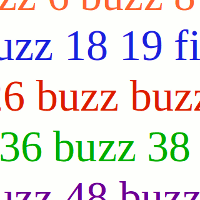By Michael Hartley
I loved this game in primary school. It's a great kids math game, especially for those needing times tables help. The rules are so simple, but force players to quickly analyse a number in several different ways. It helps push certain multiplication facts into long-term memory, by associating them with strong emotions - the excitement of the game, or the frustration of making a mistake. And by the way, it makes a decent ice-breaker game for adults too - except that adults seem to have more difficulty than kids!
To play "fizz-buzz", you need several people. They should stand, or sit, in a circle. One person is chosen to start the game, and players take turns around the circle. When the person starts, they start by saying a number from 1 to 99. (When you are teaching a class the game, they should probably always start from 1.)
The next person must then say the next number, and so on. Each person takes their turn by saying the next number in sequence... but...
This is where the game gets interesting.
- If the number is divisible by 5, the person doesn't say the number, instead, they say "Fizz!".
- Also, if the number contains a 5, the player must say "Fizz!".
- Similarly, if the number contains a 7 or is divisible by 7, they must say "Buzz!".
- These fizzes and buzzes combine together - for example, instead of 35, I would say "Fizz, fizz, buzz!", because the number contains a 5, is divisible by 5, and is divisible by 7.
- When a fizz or a buzz is said, the direction of play is reversed (from anticlockwise to clockwise, or vice-versa).
- A player who makes a mistake is penalised somehow. A good rule might be "Three strikes and you're out" of the game.
Enter a number:
The pressure really climbs when the players get into the fifties. Then, there's the double challenge of both figuring out how many fizzes and buzzes to say, and just keeping track of the numbers being spoken! The game might go like this :
- 46!
- Buzz!
- 48!
- Buzz buzz! (49 is seven times seven)
- Fizz fizz fizz! (50 is divisible by 5 twice, and also contains a 5)
- Fizz!
- Fizz!
- Fizz!
- Fizz! (What number are we up to now??)
- Fizz fizz fizz! (55 is divisible by 5, and contains two fives!)
- Fizz buzz!
- Fizz buzz!
- Fizz!
- Fizz!
- Fizz!
- 61! (Whew! We made it!)
- 62!
- 63!
- (Everybody) You're out!!!
I hate to think what it would be like to start from 699!
Here's some ideas to vary the game.
- Instead of 5 for fizz, and 7 for buzz, use different numbers. Maybe 7 and 9? Whatever times table your class needs practice with.
- For a tough challenge, have three different numbers - for example, 5 for "Fizz!", 7 for "Buzz!", and 9 for "Zap!".
- Challenge the class to come up with the most "Fizzy" or "Buzzy" number they can think of.
There are more times tables games on this site too.
